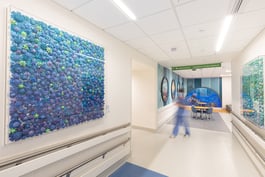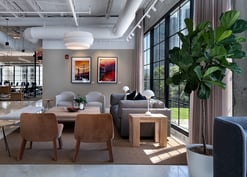While designing for experience is difficult to measure, a strategic art program emerges as an evidence-backed tool. A growing body of scientific research shows that art is a physical and measurable way to create the experiential environments that tenants crave.
The Science of Experience: How We Respond to Art
Tenants, visitors, and employees are seeking uniquely inspiring spaces that promote collaboration and innovation. Art directly supports these goals by driving engagement, enhancing cognitive function, and improving well-being.
According to theories of bodily cognition, the way we move within a space reflects how we experience it. In a 2023 study exploring how art affects behavior, researchers found that when people viewed highly gestural, abstract art, their posture and balance shifted. Participants not only had unconscious physical reactions to the art but also reported feeling drawn towards or emotionally moved by it (Kühnapfel et al.).
This engagement is not just physical. Viewing art has been shown to enhance cognitive performance and encourage creative, divergent thinking (Heruti & Mashal, 2023). Furthermore, thoughtfully selected art can support mental health and well-being. A 2025 review found that art viewing enhances feelings of purpose, improves emotion regulation, and reduces stress (Trupp et al.). By engaging us physically, cognitively, and emotionally, art becomes a functional tool for creating authentic, human-centered environments.
Why the Environment Matters
The CRE market’s pivot toward human-centric design represents an understanding that our surroundings have a direct, measurable impact on behavior and health. JLL’s 2025 design trend outlook identifies “neuro-architecture” as an emerging field, combining neuroscience, psychology, and design principles to prove why a thoughtfully designed space is a strategic asset (Hynes & Davidson).
A well-designed environment actively supports its occupants, while a poorly designed one can be a source of stress and disconnection. This is why the environment’s role as a restorative space is so critical. Restorative spaces have been shown to improve mood, reduce anxiety, and promote overall well-being (Dehove et al., 2025). Designing these spaces is key to fostering the sense of community and belonging that today’s tenants demand (Hynes & Davidson).
Securing Value and Driving Retention
Understanding the link between design and occupant satisfaction allows developers to use design integrations as a competitive advantage. As CRE leaders work to revitalize office spaces and urban hubs, tenant retention depends on creating environments that foster comfort, social connection, and well-being. However, traditional valuation models fall short in the evolving landscape where value is closely equated to experience. A 2024 study exploring how design contributes to real estate value found that conventional financial analyses often focus on structural and functional building characteristics, overlooking design elements that promote health, resilience, and sustainability (Rong et al.). This gap highlights the need for new frameworks to measure how design contributes to real estate value.
As the industry begins to recognize this, evidence shows that investing in user experience offers measurable returns. Spaces that directly enhance user health and well-being through interventions such as art programs consistently report higher retention rates (O'Connor, 2025).
Reflecting this shift, JLL’s 2025 design outlook notes many modern buildings now prioritize how a space impacts its users. The percentage of organizations with roles dedicated to community or workplace experience rose from 23% in 2024 to 35% in 2025, indicating the shift toward experiential, people-centered design (Hynes & Davidson).
In this evolving landscape, a strategic art program is not a decorative cost, but rather a direct investment in tenant health and well-being and, ultimately, retention.
How TurningArt Can Help
At TurningArt, we understand that art is a strategic tool for shaping how tenants and visitors experience a space. From curation to installation, our team collaborates with clients to design art programs that are not only visually compelling but also strategically designed with the goals of every environment. Whether the objective is to foster creativity, promote calm, or strengthen connection, each piece contributes to creating an engaging experience.
Our approach combines evidence-based design with a deep understanding of how art influences behavior, mood, and connection. By integrating artwork that resonates with both the brand and the users, we help transform spaces into meaningful environments.


Connect with an Art Advisor below to learn more!

.jpg?width=332&height=177&name=_MG_0840%20copy%20(2).jpg)


.jpg?width=332&height=177&name=dtBv_067_DSC_2139_DaNil%20(2).jpg)


